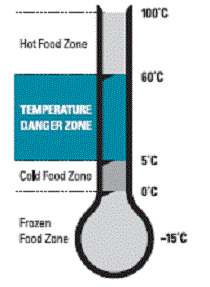Yes we know Chicago gets cold. But that doesn’t mean your restaurant‘s refrigeration doesn’t need to be watched like a hawk. The refrigeration temperatures at which foods are stored can affect a foods taste, appearance, nutrient content and most important…safety.
The United States Food and Drug Administration (FDA) set the maximum refrigerator temperature at 41 Degrees Fahrenheit.
That temperature is the maximum for the actual product being refrigerated. Do not confuse this with air temperature. A restaurant’s air temperature may fluctuate, and in Chicago that may be hot or cold, but the product temperature must remain at 41 degrees Fahrenheit or lower.
The rule of thumb is the colder the food product, the longer it will last. That makes 38 Degrees a more optimum temperature. A restaurant’s refrigeration unit set at 38 Degrees might come on at 38 Degrees and shut off at 35 Degrees. For food temperatures that require a below 35 Degrees temperature, these refrigeration and commercial freezer units require a forced defrost cycle.
Proper Restaurant Refrigeration Temperatures
(from warmest to coolest)
- Reach-in Coolers 35ºF to 38ºF
- Walk-in Coolers 35º F to 38ºF
- Reach-in Freezers +5ºF to -10ºF
- Walk-in Freezer 0º to -10ºF
- Ice Cream Freezer -10ºF to -20ºF
Educate Your Restaurant’s Staff
Talk with your restaurant’s staff and educate them on the importance of keeping refrigeration and freezer doors and drawers closed at all times. If a restaurant’s walk-in refrigerator unit doors are left open, the smallest opening will cause the box temperatures to rise.
This causes two problem’s for your restaurant:
- It will increase in room temperature due to the warm air infiltrating walk-in.
- Eventually, the evaporator coil can ice over restricting airflow to refrigerate your cabinet. (this is not good!)
When Checking Commercial Refrigeration And Freezer Temperatures
Remember that your restaurant’s commercial refrigeration unit’s temperatures will rise most often when the equipment door is open. When managing your kitchen, try and have a 5 to 10 minute time period with the commercial refrigerator or freezer door closed before calling for service if temperatures are above normal. Otherwise you’re likely going to get a false read.
Walk-in refrigeration units that have a thermometer mounted on door frame can have inaccuracies from to 2 to 5 degrees. You need to always use a secondary stem thermometer under or near the evaporator coil and wait about 10 minutes before a temperature reading. Because of their location, door thermometer’s can also fluctuate as well as having inaccuracies due to door closings and jarring over a period of time. Always have a back-up for proper temperature control.
We hope these refrigeration temperature tips help you and your Chicago restaurant.
For other tips on how your restaurant can save energy and money, be sure to follow Refrigeration on Twitter, and Fan Northeast Cooling on Facebook.
← BACK TO ALL POSTS

